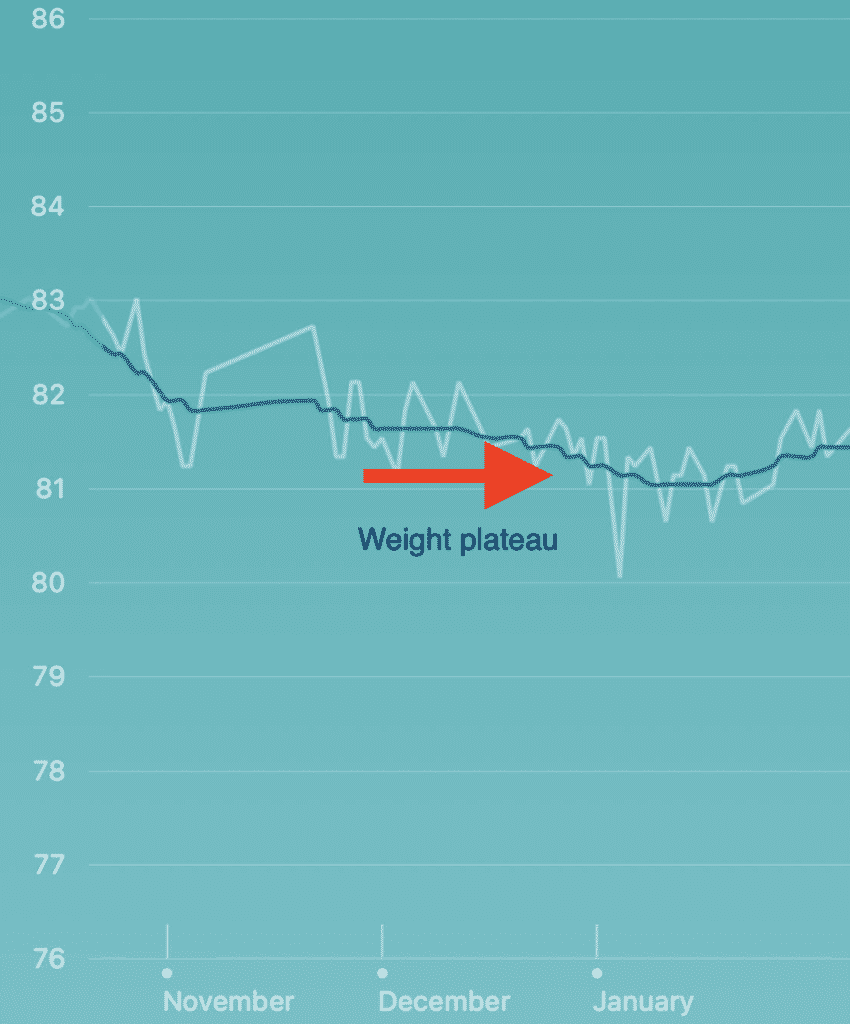- How Much Weight Can You Realistically Lose in 3 Months? - January 14, 2024
- How To Lose 1kg a Week (Guaranteed) - August 20, 2023
- How To Count Calories (or Estimate) and Stay on Track When Eating Out at Restaurants - July 25, 2023

Calorie. F**cking. Deficit.
You’ve heard it all before right?
If you want to lose weight you need to be in a calorie deficit. You know that means if your body uses approximately 2000 calories per day, you need to eat less than that to lose weight.
In fact, if that was the case you’d need to be eating 1,500 calories per day on average to lose 1lb or 0.5kg per week.
Sounds simple right?
Well, it kind of is. At least initially
The real tricky part about a calorie deficit isn’t about being in a deficit for one day, or one week, it’s about sticking to it LONG TERM. That means months rather than weeks.
Now, exactly how long you should be in a deficit for really depends on how much weight you want to lose and how quickly you want to lose it, but for most people looking to lose an average amount of weight, you’re looking at a good 3-9 months.
But How do you stay in a deficit for that long?!
Well, we need to consider a couple of things, firstly the technical elements that will actually keep you in a deficit long term, and second, the motivation and willpower techniques you can use
1. TRACK YOUR DATA ACCURATELY
This is the cornerstone of any successful diet, and maintaining a calorie deficit in the long termm.
Yes, of course, you don’t need to track calories to lose weight, you just need to be in a calorie deficit, But I’, guessing you’ve not been tracking calories your whole life and getting nowhere.
To do achieve something you’ve never achieved before, you need to do something you’ve never done before
I’m not sure if I stole that quote or made it up, but either way, it’s true.
If you’ve been shying away from tracking calories for a while then it’s time to face the music. You need to confront the bare facts of how much you actually eat face-on, or you’ll never know.
Yes, it’s not absolutely necessary for weight loss, but it takes the guesswork out of the process and speeds things up for the vast majority of people.
If you’re tracking your calories and your weight isn’t going down, you know you’re eating too much and you can do something about it.
If you’re not tracking, you’re simply flying blindfolded.
But how do you tighten up your calorie-tracking accuracy?
- Look for My Fitness Pal verified entries
These verified entries are very likely to be accurate, giving you peace of mind that you’re tracking accurately
- Weigh your food
DON’T just guess! 200g of rice will have double the calories of 100g, so it makes a huge difference. You don’t need to weigh all your food since some of it is pre-portioned (sliced bread for example), but when it comes to fresh meat, fresh fruit and veg and lose grains (e.g. oats, rice), you will need to get used to having a scale under your bowl or plate!
- Weigh raw or cooked
This is a really common mistake. Don’t weigh your food raw then track it cooked, or vice versa. 100g of cooked rice is different in calories from 100g of raw rice, so pay attention when you track
- Don’t miss anything
EVERYTHING you eat or drink counts! You shouldn’t only be tracking your ‘formal’ meals, you also need to be tracking snacks, bites and sips.
You can easily undercount by hundreds of calories if you don’t do this.
You shouldn’t only be tracking your calories though.
You also need to track your weight (ideally on a daily basis) and your steps (this can be done with Fitbit or another wearable).
Once you start tracking these three data points consistently, you’ll unlock the answer to exactly what it is you need to do to lose weight (if you aren’t already).
But without getting too complicated; pick a number of calories and amount of steps that you’ll stick to consistently for a two-week period.
For example, you might choose to do 6,000 steps per day and eat 1,800 calories per day. If after two weeks your weight hasn’t budged, you know that you need to change something.
Drop your calories by 10%, or increase your steps by 20%, and try for another two weeks. If your weight starts doing down you know you’re in a deficit
N.B. This step is vital, if you’re going to get into a calorie deficit and stay there, you need to know what’s required to get into that deficit
2. QUICKLY SPOT WEIGHT LOSS PLATEAUS
So you’re now in a deficit, great.
BUT, at some point, the calories you’re eating won’t be a deficit any more.
Why?
Nope, you’re not going into starvation mode, and no, there’s anything wrong with you.
This process is called adaptive thermogenesis. When you lose weight, your body will eventually need fewer calories to sustain itself.
For example, if you weighed 200lb (91kg), you might maintain your weight on 2,500 calories per day. This means that you’d lose weight if you ate 2,000 calories per day. If you lost weight and got down to 160lbs, you might then maintain your weight on 2,000 calories. This means that if you ate 2,000 calories, you wouldn’t lose weight, and you’d need to eat less than this to lose weight.
This is one of the main reasons people give up or assume that a calorie deficit has stopped working.
The deficit hasn’t stopped working, it’s just that you’re no longer in a deficit because of the amount of weight you’ve lost.
This is another reason you need to monitor your data closely.
If you aren’t tracking your weight daily, then you won’t know your weight has plateaued. If you’re tracking your weight but not your calories, then you won’t know how many you’re eating, and how much less you need to eat
If you’re tracking your weight and calories but not your steps, then you won’t know how many you’ve been doing and how many you need to do to carry on losing weight.
The bottom line?
Track weight, steps and calories consistently in order to make sure you maintain the calorie deficit.
Ok, ok, but what are some of the actual tactics you can use to ensure you’re sticking to your calorie targets.
Most of these tips are around creative ways to actively eat fewer calories or ways to trick your body into feeling full, so you won’t want to eat more calories anyway!
3. SKIP BREAKFAST TO SAVE CALORIES

There’s a lot of debate around whether skipping breakfast is a good idea for weight loss. As we already know, the bottom line is that if you’re in a calorie deficit, you’ll lose weight, regardless of whether you skip breakfast or not.
But, skipping breakfast can be a really easy way to help create that deficit.
This 2019 meta analysis on the effects of skipping breakfast aggregated all the studies carried out on the efficacy of skipping breakfast for weight lost and found that skipping breakfast vs eating breakfast came out on top.
The difference was 0.4kg additional weight loss and 259 fewer calories consumed per day.
Look at it like this; if you eat a 400-calorie breakfast every day, and you stop doing that, you be eating 400 calories less every day. This will mean that you eat 2,800 fewer per week. If everything else stays the same, that’s over 0.5lb of weight loss per week.
Easy.
4. INTERMITTENT FAST
Another tactic you could utilize is intermittent fasting.
Intermittent Fasting is the practice of not eating for a specific period of time each day. One popular protocol is 16:8. This means that over a 24-hour period, you’d fast for 16 hours and eat in an 8-hour window. For example, your eating window could be between 12 midday and 8 pm.
As you can probably see, Intermittent Fasting using this window is essentially the same as skipping breakfast.
Again, there is nothing magical about intermittent fasting, it’s just an easy way to eat fewer calories without thinking about it too much.
You don’t need to fast between specific times; you could fast between 8 am and 4 pm.
Or you could do a 20:4 fasting protocol, i.e. fast for 20 hours and only eat for 4, for example between 4 pm and 8 pm.
You get the picture.
Eat. fewer. calories
5. PRIORITISE HIGH VOLUME LOW-CALORIE DENSE FOODS
A calorie is a calorie. But not all calories are equal.
What the hell am I talking about?
Well, if you eat foods like;
- Lean protein (chicken, fish, lean beef)
- Fruits
- Vegetables
- Legumes and Beans
- Starchy carbs (potatoes, rice, wholegrain bread)
- Low-fat dairy (milk, yogurt)
You’ll be eating filling, healthy foods that don’t contain too many calories. These types of foods are known as high volume foods or ‘low calorie dense‘ foods. This means you get a LOT of food (volume and weight-wise) for relatively few calories.
And this is key to allowing you to stick to a calorie deficit easily. If you’re keeping yourself full, you’ll minimize the temptation to overeat.
6. AVOID CALORIE-DENSE FOODS
In the same vein, you should avoid foods that are calorie-dense, i.e foods that pack a lot of calories, but have very little volume.
Examples of these foods are;
- Oil (Olive oil, Sunflower oil)
- Butter
- Nuts
- Peanut Butter
- Chocolate
These foods won’t do much to fill you up but they do pack a lot of calories.
Below are some examples of calorie density
| FOOD | CALORIE DENSITY (KCAL/G) |
| Lettuce | 0.15 |
| Spinach | 0.23 |
| Watermelon | 0.3 |
| Strawberry | 0.32 |
| Carrot | 0.4 |
| Orange | 0.48 |
| 2% Fat Milk | 0.5 |
| Apple | 0.52 |
| Grapes | 0.69 |
| Boiled Potato | 0.87 |
| Banana | 0.89 |
| Ketchup | 1 |
| Chicken Breast (No Skin) | 1.1 |
| Brown Rice | 1.1 |
| White Fish (Tilapia) | 1.13 |
| Tuna | 1.16 |
| White Rice | 1.3 |
| Pasta (Spaghetti) | 1.31 |
| Pork Loin | 1.36 |
| Quiona | 1.43 |
| Salmon | 1.45 |
| Egg | 1.48 |
| Avocado | 1.6 |
| Whole Wheat Bread | 2.48 |
| Steak | 2.5 |
| White Bread | 2.64 |
| Burger Patty | 2.82 |
| Mozarella | 3 |
| Raisins | 3 |
| Fries | 3.07 |
| Black Beans | 3.41 |
| Frosties | 3.67 |
| Mayonaise | 3.86 |
| Nutella | 5.41 |
| Peanuts | 6 |
| Butter | 7.21 |
| Olive Oil | 8.85 |
HOW TO STAY FULL ON A CALORIE DEFICIT
You’ve probably figured out by now that staying full is vital to creating and maintaining a calorie deficit in the long term, but aside from eating filling foods, what else can you do to make it easier to stick to your deficit?
Don’t go too low on calories
It’s true that the fewer calories you eat, the quicker you’ll lose weight.
Why then, you might ask, don’t you just recommend eating 800 calories a day, or even 500 calories a day?
Well if you can stick to those kinds of low calorie amounts long-term, good luck to you.
But let me tell you a secret.
You won’t.
Super aggressive calorie deficits are simply unsustainable and you’ll end up binging and undoing all your work, or just giving up completely.
It’s like trying to sprint the entire length of a marathon. It’s possible in theory, but in reality, it’s just not going to happen.
Go with a conservative calorie deficit; I’d recommend a 500 calorie deficit per day is about right for most people.
Eat at regular intervals
I know, I know. I just told you to skip breakfast and intermittently fast.
Well, I take it all back.
For most people, the uninteresting tradition of eating breakfast, lunch, dinner and maybe a snack at regular intervals is the best approach to managing hunger.
This means that you shouldn’t ever experience excessive hunger. Your blood sugar levels will remain consistent and you shouldn’t ever feel like binging.
Don’t go crazy on exercise
I know, this sounds counterintuitive.
What have you been told in the past? If you want to lose weight, run a marathon. Do 5 HIIT classes a week, or take up boxing.
How many people do you know that have tried all of this and still not shifted any weight?
This is because your appetite will generally upregulate to match the amount of activity you’re doing.
So, if you’re burning an extra 500 calories through intense activity, the likelihood is you’ll be driven to eat back the same amount of calories (or more). This will mean your weight remains static.
Am I telling you not to exercise?
Of course not.
What I am saying is that you need to take a balanced approach to exercise. Sitting on your ass all day isn’t going to help you much, but neither is doing a crazy exercise program.
This is why I recommend regular daily walks as a great baseline level of exercise for all my online weight loss coaching clients. Walking is low intensity, low impact, anyone can do it and it won’t give you any injuries, make you feel wiped out, or stimulate your appetite too much.
How much walking you should do, of course, depends on how much weight you want to lose and how many calories you’re eating.
Consider your drinks
Drinks can be a ‘stealth’ source of calories that you might not even consider. And yes, that includes alcohol.
Stuff that you drink on a daily basis could be adding hundreds of calories to your daily total without you even realizing.
The following all contain a substantial amount of calories;
- Fruit juice
- Coke and other full-calorie fizzy sodas
- Beer
- Wine
- Cocktails
- Spirits
- Smoothies
- Tea and Coffee with milk (and whatever else Starbucks shoves into it)
- Flavoured waters
- Energy drinks (Zero Sugar Red Bull, Monster, Lucozade, etc)
- Milk
- Kombucha, Of course, you can still have all of this but it MUST be tracked, just like you track your solid food.
And be mindful that if you’re having a Starbucks Frappuccino with the full works every day, along with a ‘few’ beers or wines on a regular basis, this is going to significantly eat into your calorie budget.
The good news is that there are plenty of very low or no-calorie drinks, such as;
- Water (obviously)
- Sparkling water (go figure)
- Black coffee or tea
- Diet Coke and other diet or Zero fizzy sodas
- Zero Sugar Red Bull and Monster Ultra
Caffeine
Caffeine can help with blunting your appetite.
This is a double win for coffee lovers because it means you can still have your caffeine fix (which will have zero calories if you don’t add anything) PLUS you’ll be less hungry for more calories.
Most people would do better consuming caffeine early in the morning because a high caffeine intake later in the day could interrupt sleep.
So, if you’re planning on skipping breakfast or using intermittent fasting, coffee could really help you stick to your plan.
A FINAL POINT ON HUNGER
When you diet, hunger is totally normal.
The aim of the tips above is to minimize hunger as much as you can, but not totally eliminate it.
When you’re in a calorie deficit, the body will be burning stored fat for energy (this is what you want!), and this can cause a hormone called Leptin (the hunger hormone) to be produced because your body thinks it’s not getting enough nutrients.
So, at certain points in your diet, you will need to be comfortable with being hungry.
But if you use the mental cue that hunger = bodyfat being burned, you’ll feel much better about it!
SUMMARY
Creating a calorie deficit is the only way to lose weight, but sticking to that deficit long term and maintaining that deficit it is what will determine whether your diet is successful or not.
Ensuring you’re hungry and healthy is the best way to ensure that you stick to your deficit, and that can be achieved by using some of the tips above.
REFERENCES
Adaptive thermogenesis in humans: https://www.ncbi.nlm.nih.gov/pmc/articles/PMC3673773/
Effect of breakfast on weight and energy intake: systematic review and meta-analysis of randomised controlled trials: https://www.ncbi.nlm.nih.gov/pmc/articles/PMC6352874/
Intermittent fasting and weight loss: https://www.ncbi.nlm.nih.gov/pmc/articles/PMC7021351/



Leave a Reply